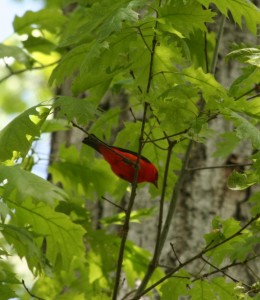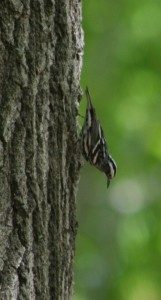Look Up in the Trees: It’s Warbler Heaven at the Garden
Posted in Wildlife on May 12 2010, by Plant Talk
Colorful Gems Spotted on Bird Walks During Spring Migration
 |
Debbie Becker leads a free bird walk at the Garden every Saturday from 11 a.m. to 12:30 p.m. beginning at the Reflecting Pool in the Leon Levy Visitor Center. Photos of scarlet tanager and black-and-white warbler: Debbie Becker |
 The spring bird migration is in full swing at the Garden. Recent bird walks have been a treat to the eyes and ears. Warblers are everywhere!
The spring bird migration is in full swing at the Garden. Recent bird walks have been a treat to the eyes and ears. Warblers are everywhere!
Warblers are small, colorful birds that migrate from areas of Central and South America to northern points in Canada and the United States. Once there, they build nests, reproduce, raise young, and then migrate back south in the fall.
Warblers are insect eaters and arrive just in time to feast on newly hatched insect larva. The warblers pass through the New York area mid-April to mid-May. Their beautiful songs and colorful feathers are enough to make any birder dizzy with delight.
This year searching for warblers is especially difficult because the trees bloomed earlier than usual due to the summer-like weather we had in April. With all the leaves on the trees, it is hard to find the songbirds as they dart about foraging for food. But diligence pays off. On our walks we’ve been treated to wonderful sightings, including the blackburnian warbler, a beautiful bird with an orange “fire throat.” All of the birders oohed and aahed as they strained their necks to see its throat—more orange than orange should be.
 We also were lucky enough to hear the lazy zoo-zee-zoo-zoo-zee of the black-throated green, a colorful warbler of the woods whose song is very recognizable. Spotting him on a high branch, we got a quick glimpse of his brightly colored markings. Other warbler highlights have included: yellow-rumped, northern parula, common yellowthroat, northern waterthrush, black-throated blue, palm, magnolia, prairie, black-and-white (pictured at left), bay-breasted, and blackpoll.
We also were lucky enough to hear the lazy zoo-zee-zoo-zoo-zee of the black-throated green, a colorful warbler of the woods whose song is very recognizable. Spotting him on a high branch, we got a quick glimpse of his brightly colored markings. Other warbler highlights have included: yellow-rumped, northern parula, common yellowthroat, northern waterthrush, black-throated blue, palm, magnolia, prairie, black-and-white (pictured at left), bay-breasted, and blackpoll.
At the end of one of the bird walks we were flashed by a Baltimore oriole. His bright orange and black feathers were a sight to behold. Orioles tend to build their nests over water or sometimes blacktop. Their nests are long and hang down like a sock. A junior male, possibly from the previous year’s fledging, helps the breeding male and female build the nest and raise young. It is thought that by doing this the junior will learn parenting skills for the following year.
Eastern kingbirds, which are superb at catching insects, can be seen at the Garden, showing their black and white feathers and white tail stripe as they hover over Twin Lakes looking for tasty flying morsels.
Warbling vireos are also a welcomed addition to spring at the Garden. Their persistent song fills the air as they forage for insects. Blue-headed vireos and red-eyed vireos are also wonderful migrants seen at the Garden. Even with all this birding excitement the one bird that everyone yearns to see and the one that never disappoints is the scarlet tanager (top photo). A bright-red bird with black wings, the tanager is on everyone’s list as the most beautiful bird in the forest.
With warbler migration in full peak, aching necks from straining to see these birds flitting around the tree canopy—aptly called “warbler neck”—will likely abound. But I don’t think anyone will really complain as nature puts on its best birding show of the year.
Editor’s note: Speaking of birds, the female red-tailed hawk that nested and raised three young at the Garden last year is back at Fordham University this year with a new mate and two nestlings. See photos of the new family by Professor Rich Fleisher.


Dear Debbie,
Thank you for the great tour in March! My daughter and I had special time with nature.
Sincerely,
Ai
May 14,2010 at 11:45am